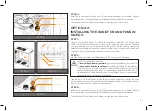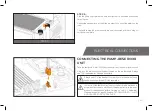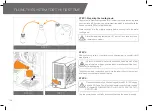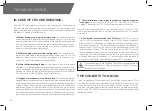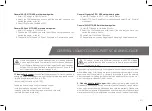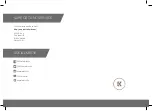
/ 31 /
GENERAL LIQUID COOLING PARTS CLEANING GUIDE
General ASUS Z170/X99 motherboard guide:
1. Enter UEFI and go to QFAN Control
2. Select the FAN header you wish to edit (the one that you have con-
nected the pump- or fan to)
3. Select PWM mode (instead of DC)
General ASRock Z170/X99 motherboard guide:
1. Enter UEFI and go to H/W Monitor
2. Choose the FAN header you wish to edit (the one that you have con-
nected the pump- or fan to)
3. Change from ‘Full Speed’ to ‘Silent’, ‘Standard’ or ‘Performance’ mode
General Gigabyte Z170/X99 motherboard guide:
1. Enter UEFI and go to M.I.T. - > PC Health Status
2. Select (CPU Fan) Speed Control optionbox and select ‘Auto’, ‘Normal’
or ‘Manual’.
General MSI Z170/X99 motherboard guide:
1. Enter UEFI and go to Hardware Monitor
2. Select the FAN header you wish to edit (the one that you have con-
nected the pump- or fan to)
3. Enable Smart Fan Mode Checkbox
4. Change ramp-up curve by dragging and dropping 4 coloured squares
Liquid cooling parts may be disassembled for cleaning purposes
on an occasional basis. Your warranty is not voided on disassem-
bly of the water block but the customer loses the EK leak-free guar-
antee which comes with a factory tested Component. And old, but
soft toothbrush is an excellent cleaning tool!
1. Cleaning bare copper:
When cleaning bare copper is it recommended to
use slightly acidic cleaning agents which include the following organic agents:
- (white) vinegar (acetic acid up to 5-10%)
- lemon juice (citric acid up to 5-10%)
Certain food can also be used for cleaning copper:
- cola (contains phosphorous- and citric acid)
- ketchup or tomato extract (contains acetic- and citric acid)
- mustard (contains acetic acid)
5% vinegar , diluted with 95% water is enough to kill 99.9% of algae
and bacteria that could be present on copper in an unmaintained
cooling loop as well.
Upon cleaning is it necessary to flush the water blocks in water and rinse them
with distilled water. After rinsing we recommend soaking the water blocks in
paper towels until completely dry. It is nearly impossible to avoid the naturally
occurring copper tarnishing (oxidation) as the oxidation will reoccur the mo-
ment the copper is cleaned of the all oxides.
2. Cleaning nickel plated copper:
When cleaning nickel plated copper it is
forbidden to use any aggressive chemicals (neither vinegar) or rough materi-
als as you may damage the plating and thus void the warranty. Please note
also that due to presence of dye additives and other chemicals the nickel layer
may also become discolored/stained over time period. However the staining

